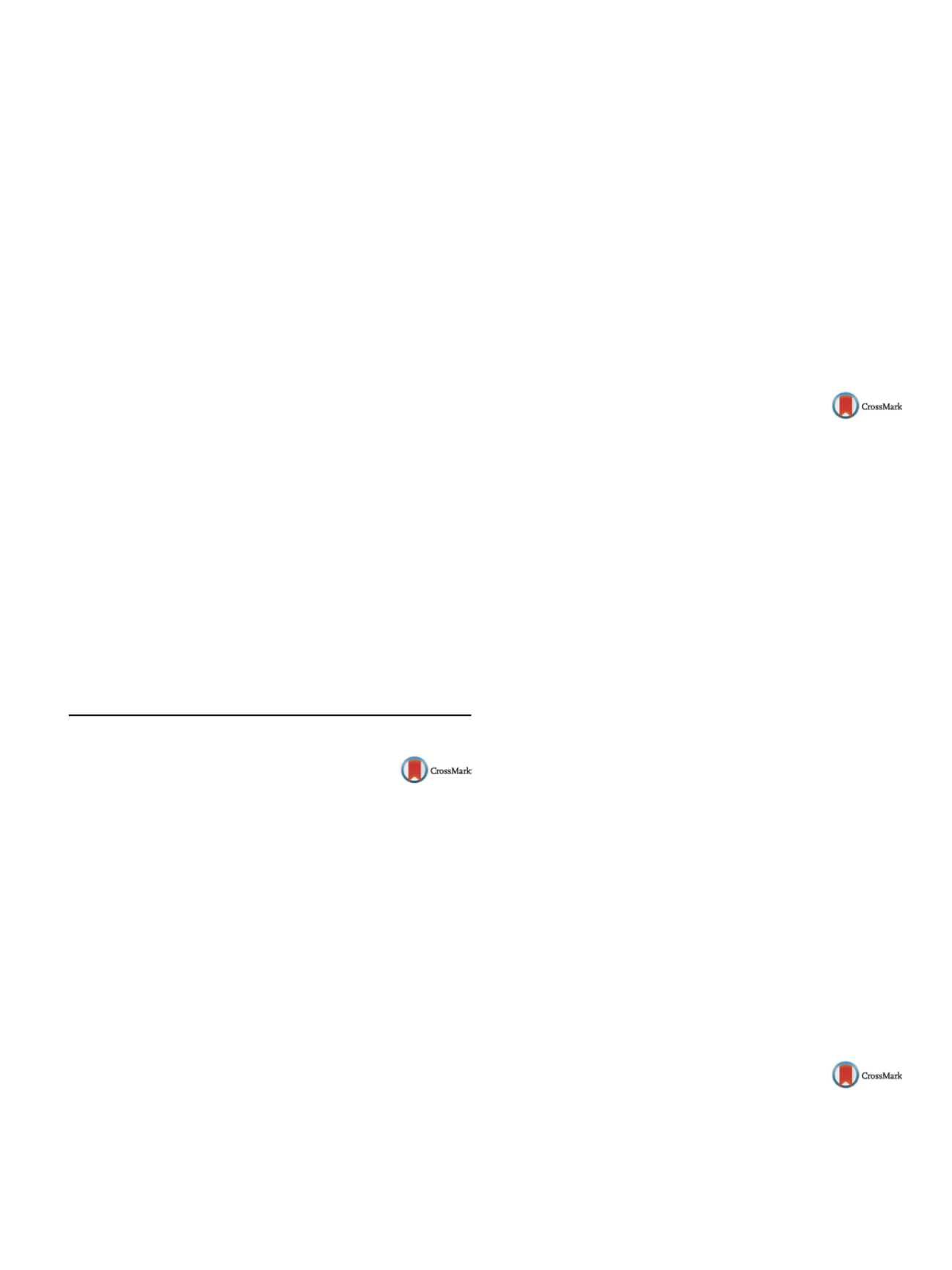

25th European congress of psychiatry / European Psychiatry 41S (2017) S365–S404
S373
2
Xi’an Mental Health Center, Science and Education Department,
China
∗
Corresponding author.
Objective
To investigate the effect of Qing Huan Ling and (or)
risperidone on activity and preferences behavior of the hypoglu-
tamatergic schizophrenia model in mice.
Methods
Seventy kunming mice were randomly divided into 5
groups, one group as placebo group. The rest groups intraperitoneal
injection MK-801 continuously 14 day, then randomly numbered:
model group, Qing Huan Ling group, risperidone groupand Qing
Huan Ling combined risperidone group. Intragastric administration
give corresponding drugs for each group one month, at the same
time observe high activities and changes in the preferences of five
groups.
Results
Comparedwith the blank group, activity of the restmodel
groups induced by MK-801 was increased (
P
< 0.05). After intra-
gastric administration one month, model groups of high activity
was decreased, especially risperidone combined Qing Huan Ling
group. There was no statistical meaning in inquiry activity of five
groups (
P
> 0.05). Compared with model group, latent period of
step-through test was prolonged 35.5 s (
P
< 0.05), of step-down
test was prolonged 11.4 s in risperidone combined Qing Huan Ling
group.
Conclusion
The combination of Qing Huan Ling and risperidone
can suppress the high activity; also can protect harmed memory of
the preference behavior in the hypoglutamatergic schizophrenia
model in mice.
Disclosure of interest
The authors have not supplied their decla-
ration of competing interest.
http://dx.doi.org/10.1016/j.eurpsy.2017.02.387e-Poster Walk: Psychosurgery & stimulation
methods (ECT, TMS, VNS, DBS) and
psychophysiology
EW0774
Description of anesthetic drugs used
in hospital del Mar and their impacts
on convulsion duration and blood
pressure in electroconvulsive therapy
M. Angelats
1 ,∗
, A. Leila
1, C. David
1, P. Laia
1, M. Laura
1, E. Itziar
1,
B. Adinson
2, S. Purificación
1, P. Víctor
1, B. Dani
11
Instituto de Neuropsiquiatría y Adicciones INAD, Parc de Salut Mar,
Psiquiatría, Barcelona, Spain
2
Fellow of the Royal College of Physicians of Canada, Psychiatry,
Quebec, Canada
∗
Corresponding author.
Introduction
The electroconvulsive therapy (ECT) is an effective
treatment used for several psychiatric disorders. However, there
are multiple enigmas about the mechanisms of action and factors
that improve its results. Some frequent questions are if the anes-
thetic drug makes a difference in the time of convulsion and blood
pressure.
Aims
Our principal aim is to describe the utilization of anesthetic
drugs among the patients that are being treated with ECT in hos-
pital del Mar. We also want to know the differences in the time of
convulsion and systolic arterial pressure for every anesthetic drug
(propofol, thiopental and etomidate).
Material and methods
We have used the database of ECT in
hospital del Mar. It contains information like age, principal diag-
nosis, medical background and pharmacological treatment at the
moment of starting ECTs; it also contains information of each indi-
vidual ECT session as basal, 2 and 5minutes arterial pressure; the
anesthetic drug used, and convulsion duration.
We made an analysis of general conditions of the population, the
differences of convulsion time and arterial pressure between the
three anesthetic drugs.
Results
Propofol was used in 1140 sessions, thiopental in 61 ses-
sions and etomidate in 54 sessions. The differences in the means of
convulsion times between propofol and etomidate are statistically
significant (“
P
” value < 0.05). Etomidate or thiopental increases the
difference of arterial pressure more than propofol.
Conclusions
Further research about the factors that improve con-
vulsion duration and minimize adverse effects on blood pressure is
needed.
Disclosure of interest
The authors have not supplied their decla-
ration of competing interest.
http://dx.doi.org/10.1016/j.eurpsy.2017.02.388EW0775
An evaluation of the use of
electroconvulsive therapy in a United
Kingdom high secure psychiatric
hospital
H. Blott
∗
, S. Bhattacherjee , E. Harris
West London Mental Health trust, Forensic Psychiatry, London,
United Kingdom
∗
Corresponding author.
Introduction
Electroconvulsive therapy (ECT) is an effective
NICE-approved treatment for severe depression, treatment-
resistant mania and catatonia; the Royal College of Psychiatrists’
(RCPsych) guidelines also support its use fourth line for treatment-
resistant schizophrenia.
Objectives
Evaluate the use of ECT at Broadmoor High Secure psy-
chiatric hospital, focusing on the indications for its prescription and
patients’ capacity to consent.
Method
Analyse case records of all patients who received ECT,
and of all patients referred for Second Opinion Appointed Doc-
tor (SOAD) certified ECT treatment under Section 58 of the Mental
Health Act 1983 (MHA) due to incapacity, between 01.09.11 and
30.07.15.
Results
All patients lacked capacity to consent to treatment dur-
ing this time. Thirty-three referrals were made to the SOAD service
for 15 patients, and of these 30 resulted in certification (T6) of which
10 were not subsequently used. Improvements in mental state and
agreement to take clozapine were common reasons for T6s either
not being certified or used. Urgent treatment under Section 62 of
the MHAwas employed 7 times for 4 patients during this period. Of
the referrals to the SOAD service, 25 were for treatment-resistant
schizophrenia, 5 for mania, 3 for catatonia and none for depression.
Conclusions
Those patients requiring ECT within this population
tended to be the most unwell and all lacked the capacity to consent
to it. The majority (76%) of patients receiving ECT at Broadmoor do
so outside of NICE (but within RCPsych) guidelines. ECT may be an
effective strategy for promoting compliance with clozapine.
Disclosure of interest
The authors have not supplied their decla-
ration of competing interest.
http://dx.doi.org/10.1016/j.eurpsy.2017.02.389EW0776
Predictive response factors of
repetitive transcranial magnetic
stimulation in treatment-resistant
depression
B. Calvet
1 , 2 , 3 , 4 ,∗
, O. Gardère
1, M. Girard
1, J.P. Clément
2 , 3 , 41
Esquirol Hospital Center, Department of Research and
Neurostimulation, Limoges, France


















